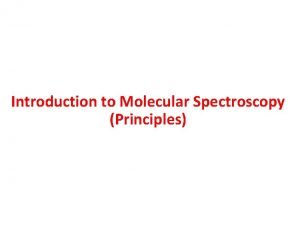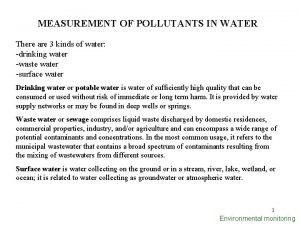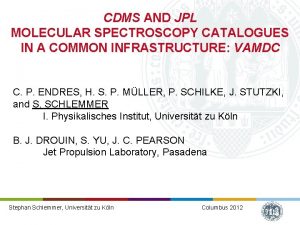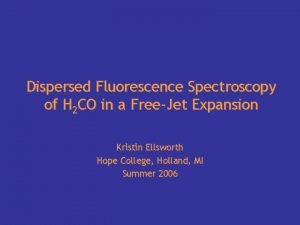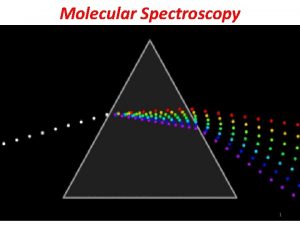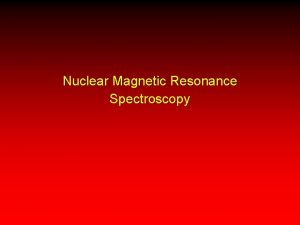Introduction to Molecular Spectroscopy Principles Every molecular species










- Slides: 10

Introduction to Molecular Spectroscopy (Principles)

Every molecular species is capable of absorbing its own characteristic frequencies of electromagnetic radiation. This process transfers energy to the molecule and results in a decrease in the intensity of the incident electromagnetic radiation. Absorption of the radiation thus attenuates the beam in accordance with the absorption law. In terms of the photon model, attenuate means to decrease the number of photons per second in the beam.

The Absorption of Light • The Beer Lambert law tells us quantitatively how the amount of attenuation depends on the concentration of the absorbing molecules and the path length over which absorption occurs. • As light traverses a medium containing an absorbing analyte, the intensity decreases as the analyte becomes excited. • For an analyte solution of a given concentration, the longer the length of the medium through which the light passes (path length of light), the more absorbers are in the path, and the greater the attenuation. • Similarly, for a given path length of light, the higher the concentration of absorbers, the stronger the attenuation. • The term monochromatic radiation refers to radiation of a single color; that is, a single wavelength or frequency. • In practice, it is virtually impossible to produce a single color of light.

Ultraviolet and Visible (UV/VIS) Molecular Absorption Spectroscopy • The absorption of ultraviolet / visible radiation is widely used to identify and determine many inorganic, and biochemical species. • Ultraviolet and visible molecular absorption spectroscopy is used primarily for quantitative analysis and is probably applied more extensively in chemical and clinical laboratories than any other single technique.

Ultraviolet and Visible (UV/VIS) Molecular Absorption Spectroscopy • Several types of molecular species absorb ultraviolet and visible radiation. • Molecular absorption by these species can be used for qualitative and quantitative analyses. • UV visible absorption is also used to monitor titrations and to study the composition of complex ions.

Absorbing Species • Absorption of ultraviolet and visible radiation by molecules generally occurs in one or more electronic absorption bands, each of which is made up of many closely packed but discrete lines. • Each line arises from the transition of an electron from the ground state to one of the many vibrational and rotational energy states associated with each excited electronic energy state. • Because there are so many of these vibrational and rotational states and because their energies differ only slightly, the number of lines contained in the typical band is quite large and their separation from one another is very small.

Absorption by Organic Molecules • Absorption of radiation by organic molecules in the wavelength region between 180 and 780 nm results from interactions between photons and electrons that e ither participate directly in bond formation (and are thus associated with more than one atom) or that are localized about such atoms as oxygen, sulfur, nitrogen, and the halogens. • The wavelength of absorption of an organic molecule depends on how tightly its electrons are bound. • The shared electrons in carbon or carbon hydrogen single bonds are so firmly held that their excitation requires energies corresponding to wavelengths in the vacuum ultraviolet region below 180 nm.

Absorption by Organic Molecules • Single bond spectra have not been widely exploited for analytical purposes because of the experimental difficulties of working in this region. • These difficulties occur because both quartz and atmospheric components absorb in this region, which requires that evacuated spectrophotometers with lithium fluoride optics be used. • Electrons in double and triple bonds of organic molecules are not as strongly held and are therefore more easily excited by electromagnetic radiation. • Thus, species with unsaturated bonds generally exhibit useful absorption bands. • Unsaturated organic functional groups that absorb in the ultraviolet or visible regions are known as chromophores.

Qualitative Applications of UV/VIS Spectroscopy • Often, you can get an idea as to the identity of the absorbing groups by comparing the spectrum of an analyte with those of simple molecules containing various chromophoric groups. • Usually, however, ultraviolet spectra do not have sufficient fine structure to permit an analyte to be identified unambiguously. • Thus, ultraviolet qualitative data must be supplemented with other physical or chemical evidence such as infrared, nuclear magnetic resonance, and mass spectra as well as solubility and melting and boiling point information.

Quantitative Applications of UV/VIS Spectroscopy • Ultraviolet and visible molecular absorption spectroscopy is one of the most useful tools available for quantitative analysis. • The important characteristics of spectrophotometric and photometric methods are: • Wide applicability • High sensitivity • Moderate to high selectivity • Good accuracy • Ease and convenience
 Applications of uv and visible spectroscopy
Applications of uv and visible spectroscopy Difference between atomic and molecular spectroscopy
Difference between atomic and molecular spectroscopy Difference between atomic and molecular spectroscopy
Difference between atomic and molecular spectroscopy Upcdms
Upcdms International symposium on molecular spectroscopy
International symposium on molecular spectroscopy A keystone
A keystone Terahertz spectroscopy principles and applications
Terahertz spectroscopy principles and applications Principles of atomic emission spectroscopy
Principles of atomic emission spectroscopy Principles of fluorescence spectroscopy
Principles of fluorescence spectroscopy Every nation and every country has
Every nation and every country has Microsoft vision statement
Microsoft vision statement
